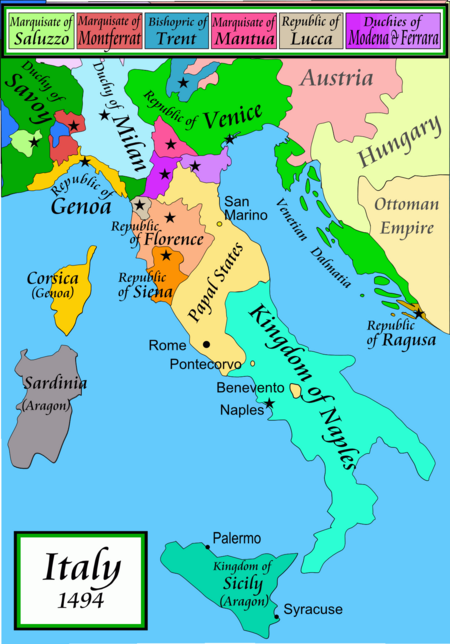
Prelude
The political situation by the late 15th century in Italy had been becoming more and more complex as time had gone on. In particular, the Kingdom of Naples ruled by King Ferdinand I, or Ferrante, was an illegitimate son of Alfonso V of Aragon making Ferrante not Italian but from the Iberian Peninsula.
Also, Ferdinand I had been excommunicated by the Pope further straining the relations between the two Italian states, while demonstrating the power that the Papacy had not just over Italian but also European politics. Charles VIII, the young king of France, had a claim to the throne of Naples and was encouraged to press it from the Pope Innocent VIII and Ludovico Sforza, the newly made Duke of Milan, as both had reasons to dethrone Ferrante. Sforza sought to remove another powerful Italian state that was challenging his rule of Milan as Ferrante and his son had claims to Milan.
However, Ferrante died in early 1494 leaving the throne of Naples to his son Alfonso II who was seeking to press his claim against the Duke of Milan, Sforza, who had controlled Milan for many years prior. An important aspect to note before going onward is how these events would tie in to how Machiavelli believed that the power that princes held came from their hereditary rule. For example, Machiavelli states in The Prince that, “…hereditary states accustomed to the rule of their princes’s family there are far fewer difficulties in maintaining them than in new states.” This shows how important it is for political leaders to have some sort of familial tie to their territory as it makes it that much easier for them to hold it.

Conflict
Encouraged to invade Italy by Ludovico Sforza in 1494, Charles VIII of France invades with an army numbering at about 25,000 troops, 8,000 of which are Swiss mercenaries that were highly trained from having fought in wars previously. One of the first engagements of the war involved those same Swiss mercenaries led by Charles VIII’s brother Louis, who led an attack on the town of Rapallo that drove out the Neapolitan force there. However, after the battle the Swiss mercenaries would go on to sack the town, causing much misery to the Italian residents and cementing a distaste for foreign mercenaries in Italy.
While the Swiss mercenaries were a formidable force for Charles VIII, he had at his disposal highly trained artillery men that would prove to be invaluable throughout the invasion for their skill with canons. Leaving much devastation in their wake, the French invasion force made its way to Florence by November 1494, forcing the citizens of Florence to decide what to against a French force that had devastated other towns in Italy before them. Eventually, Florence surrendered to the French, which opened the way for the invasion to pass through central Italy and reach the Kingdom of Naples by February of 1495. After the French arrived in Naples the city was quickly taken, forcing Alfonso II into exile and Charles VIII combining the Kingdoms of France and Naples. However, the ferocity and devastation wrought by the French invasion spurred many of the Italian states to unite to expel the French creating the League of Venice in 1495 with the help of the Pope Alexander VI.
The League of Venice would include: the Pope, Ferdinand II of Aragon, Maximilian I of the Holy Roman Empire, Sforza of Milan, and the Republic of Venice. This shows the power that a foreign invasion had on the multiple Italian states and how even in times of crisis the Italian states will try to band together to fend off a greater threat. Charles VIII was, however, undeterred and marched from Naples and was able to deliver a decisive blow to the League at the Battle of Fornovo where the smaller French army of about 10,000 soldiers was able to defeat a bigger League army of 20,000 soldiers. With this victory, Charles VIII would no longer be trapped in Naples but was now cut off from his gains in Naples, which was taken back by the son Alfonso II Ferdinand II later in 1495. Charles VIII would later attempt to take back his conquests in Italy but would later die in 1498 at the age of 27 due to an unforseen accident passing the French throne to his brother Louis XII.
Aftermath
The aftermath of the First Italian War may seem to have no clear cut winners as the Charles VIII succeeded in taking control of Naples, but was later driven out of Italy by the League of Venice. While this was ostensibly a victory for the League, it came at great cost as Italy had been ravaged by the war and Italy had just been proven that foreign powers could invade Italy at will. All that would be needed to invade Italy was a country that had about the same means as France in order to make Italian conquest a reality and this would prove to be a few countries that could fit this description. A very important political consequence regarding the First Italian War was that a marriage alliance occurred between the Holy Roman Emperor Maximilian I and the Kingdom of Spain that was ruled by the Catholic Monarchs Ferdinand and Isabella. Maximilian I’s son Philip the Handsome was to marry their daughter Joanna which would bring the House of Habsburg into Spain that would bring far-reaching consequences for the history of Europe. It also speaks to the importance that political marriages had during this time period as by expanding the number of family members across various monarchies, it becomes easier for that family, in this case the Habsburgs, to be able to maximize their political power.